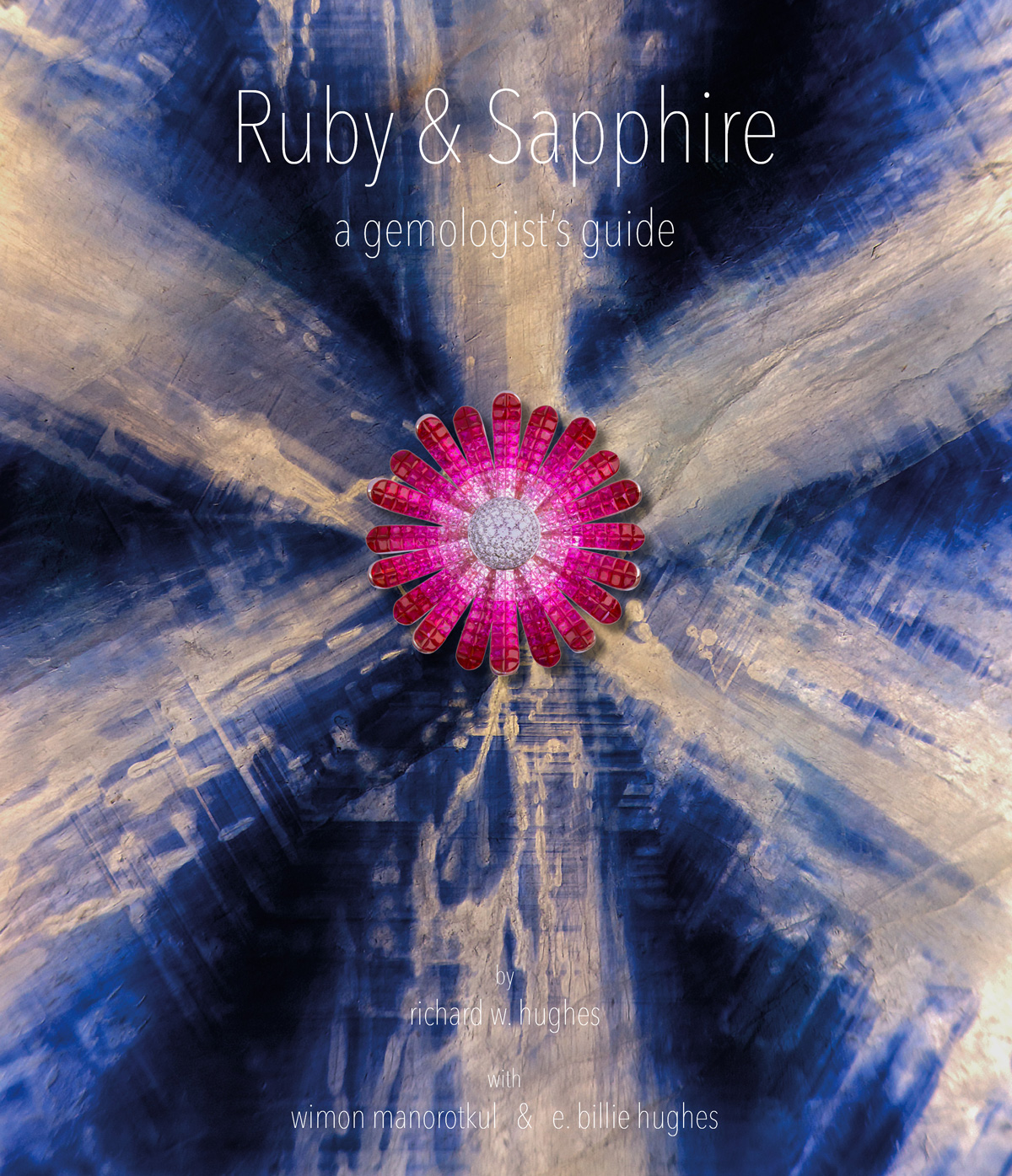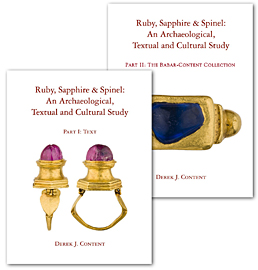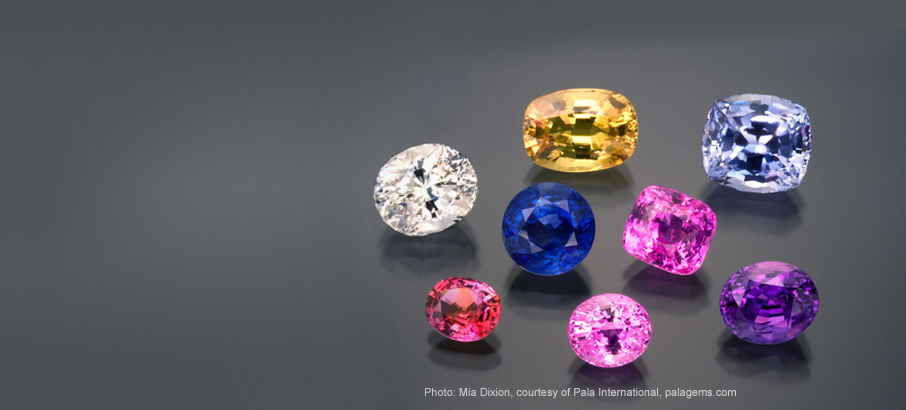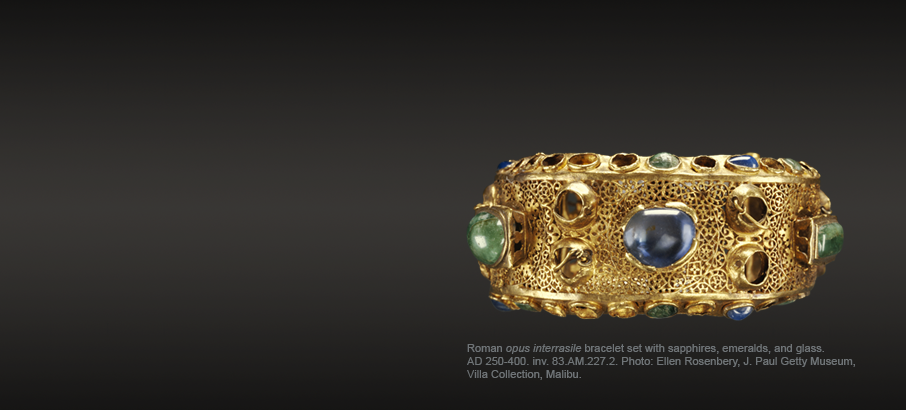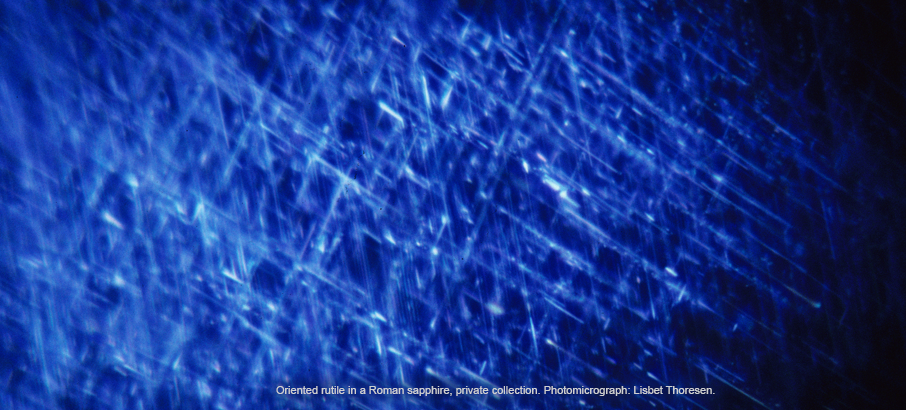FOURTEENTH ANNUAL SINKANKAS SYMPOSIUM – SAPPHIRE
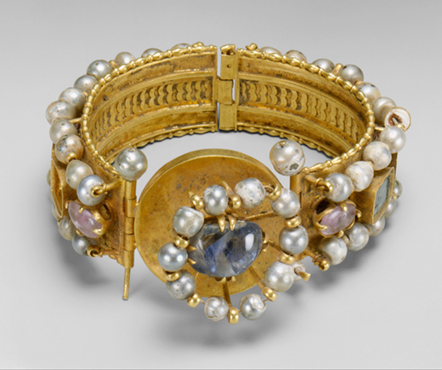
One of a pair of Byzantine gold bracelets adorned with silver ornamentation and pearls, amethyst, sapphire, glass, quartz and "emerald plasma," ca. AD 500–700; overall dimensions: 3.7 x 8.2 cm. Inv. 17.190.1670, gift of J. Pierpont Morgan, 1917, Metropolitan Museum of Art, New York.
Registration is now open.
Register online
(See details below)
Named for one of the most distinguished and influential figures in gemology and mineralogy, the Sinkankas Symposium is an annual one-day event featuring presentations by noted specialists working in diverse gem-related disciplines. The theme of the Fourteenth Annual Sinkankas Symposium is Sapphire.
The Sinkankas Symposium has been described as the most important gemological conference in North America by respected authorities on gemstones. Organized by Roger Merk for 13 years (2003–2015), the annual event is co-sponsored by the Gemological Society of San Diego and GIA (Gemological Institute of America), which has provided the Symposium venue every year. Bill Larson has been a generous supporter and speaker at the event since its inception.
FOURTEENTH ANNUAL SINKANKAS SYMPOSIUM – DATE and VENUE
Saturday, April 8, 2017
GIA (Gemological Institute of America)
World Headquarters and The Robert Mouawad Campus
5345 Armada Drive
Carlsbad, CA 92008
FOURTEENTH ANNUAL SINKANKAS SYMPOSIUM – SPEAKERS *
Recognized specialists in fields ranging from geology and mineralogy to history, treatment, cutting, collecting and selling will make presentations on Sapphire.
Edward Boehm – Sapphire Origin Determination: Past and Present – bio »
Edward Boehm is a colored stone dealer and consultant from Chattanooga, Tennessee. He began his gemological studies in Switzerland. There he spent the summers of his youth under the tutelage of his grandfather, Edward Gübelin, piquing his curiosity in crystals and gems. Upon graduating with degrees in geology and German from the University of North Carolina, Chapel Hill, he went on to obtain the Graduate Gemologist diploma from GIA in 1988, followed by the Certified Gemologist title from the AGS in 1996. He also completed the SSEF advanced laboratory gemology course under the tutelage of Prof. Henry Hänni in 1998. Mr. Boehm was recently awarded an honorary FGA from the Gemmological Association of Great Britain.
Dr. John Emmett – All the Colors of Corundum – bio »
Dr. John L. Emmett received a B.S. in physics from California Institute of Technology, followed by a Ph.D. in physics from Stanford University. Dr. Emmett was an associate director of the Lawrence Livermore National Laboratory and director of its laser program for 16 years. Dr. Emmett had responsibility for laser physics research and engineering for inertial confinement fusion, laser isotope separation, and advanced laser development, including development and construction of what was then the world's most powerful solid state laser system (NOVA). Dr. Emmett was a founder of both ILC Technology and Crystal Chemistry and has served on the board of directors of Schott Fiber Optics, Inc. and Hoya Corporation USA. Dr. Emmett has published extensively in the scientific literature and holds several patents in the fields of lasers and materials. He is currently a consultant to GIA and recently completed teaching an extensive course on the physics and chemistry of ruby and sapphire. Dr. Emmett is retired in Brush Prairie, Washington, where he maintains an extensive spectroscopy research laboratory in his home.
Dr. George Harlow – Syenite-Hosted Sapphires – What's Going On – abstract »
George E. Harlow is curator of minerals and gems in the Department of Earth & Planetary Sciences at the American Museum of Natural History, New York City. He is responsible for the museum's Morgan Memorial Hall of Gems and the Harry Frank Guggenheim Hall of Minerals. Dr. Harlow studies minerals to explore their crystal chemistry, interpret the record of events stored in them, understand the rocks of which they are a part, and place it all in an Earth system context. These interests and questions about specimens in the Museum's gem collection led Dr. Harlow to a continuing study of jadeite jade and related rocks from central Guatemala. Recent studies have included sourcing archaeological jadeite jade from Antigua, West Indies, and Emirau Island, Papua New Guinea, as well as research on the mineralogy and origin of ruby at the Mogok Tract, Myanmar. He has also carried out high-pressure experimental studies on the crystal chemistry of large ions in the Earth's upper mantle. Dr. Harlow has curated and co-curated several exhibitions at the Museum, including It's Gold (1979–80), Tiffany: 150 Years of Gems and Jewelry (1988), and Global Warming (1992). Dr. Harlow was the organizer of the Nature of Diamonds exhibition (1997–2002 and 2007–2010). He is an adjunct professor in the City University of New York graduate program and a senior research associate at Columbia University's Lamont-Doherty Earth Observatory, where he conducts some of his research. Dr. Harlow joined the Museum in 1976 as an assistant curator in the Department of Mineral Sciences (renamed the Department of Earth and Planetary Sciences in 1996). Dr. Harlow received his B.A. in geology from Harvard College in 1971 and his Ph.D. in geology from Princeton University in 1977.
Alan Hart – Sapphires in the Crown Jewels – bio »
Alan Hart is head of collections and mineralogy collections at the Natural History Museum in London. Mr. Hart is currently head of earth sciences collections, having been collections leader for mineralogy and former curator of mineralogy since 1981. He has insight in collections strategy and developing strategic missions to expand research and public engagement. As a mineralogist and qualified gemologist, he has a passion for earth sciences and established global links within the research, trade, and dealer environments. Mr. Hart has worked in close collaboration with the private collector community to develop significant collections at the Museum. He has developed and curated major exhibitions, including Diamonds and The Vault, and undertaken various media activities representing geoscience. He has contributed exhibitions and lectures to numerous geoscience trade shows. Mr. Hart is CEO of the Gemmological Association of Great Britain. His personal research within the gem and mineral is wide-ranging but currently focuses on the cutting of famous Mogul diamonds, gem identification and appraisal, and the provenance of gem materials.
Richard Hughes – Sapphire Around the World – bio »
Richard W. Hughes is widely regarded as one of the world's foremost experts on ruby and sapphire. The author of several books and more than 160 articles on gems and gemology, his writings and photographs have appeared in a diverse range of publications. In a lengthy career, Mr. Hughes has received numerous industry awards. A recipient of the 2004 Edward J. Gübelin Most Valuable Article Award from Gems & Gemology journal, the following year he was awarded the American Gem Society's Richard T. Liddicoat Journalism Award. In 2010, he received the 2010 Antonio C. Bonanno Award for Excellence in Gemology from the Accredited Gemologists Association. The Association Française de Gemmologie (AFG) in 2013 named him one of the 50 most important figures that have shaped the history of gems since antiquity. His latest book, Ruby & Sapphire: A Gemologist's Guide (2017), is arguably the most comprehensive volume ever devoted to a single gem species. Mr. Hughes resides in Bangkok, where he and his wife, Wimon, and daughter Billie operate Lotus Gemology, the world's only gem lab totally devoted to ruby, sapphire and spinel.
Bill Larson – A Collector's Perspective: Sapphire Crystals from Worldwide Localities – bio »
Bill Larson began his interest in gems and minerals at a very early age when he combed the hills of San Diego County with his father and Josephine Scripps and John Sinkankas in search of fine crystals. He earned an advanced degree in geological engineering from the Colorado School of Mines.
In 1968, Mr. Larson and then-partner Ed Swoboda purchased three gem mines in the Pala mining district—the Tourmaline Queen, Stewart Lithia, and Pala Chief, whose histories date to the 1800s. Mr. Larson stepped onto the international stage in 1972 when an extraordinary strike established his company and the Pala mining district as one of the world's premier sources of tourmaline.
As president of Pala International Inc., Mr. Larson heads one of the industry's leaders among gemstone import, lapidary, and mining operations internationally. He and his wife, Jeanne, own The Collector, a retail shop in Fallbrook that showcases fine colored stones, jewelry, and objets d'art. Today, Mr. Larson travels the world as a guest lecturer, media spokesperson, and authority on minerals and gems, the mining industry, and colored stone pricing.
Glenn Lehrer – The Art and Science of Faceting and Carving Sapphire – bio »
Glenn Lehrer is regarded as one the finest living gemstone artists of our time. His precisely faceted stones and fluid, intricate carvings are known the world over for their original concepts, mastery of design, and unique interaction with light. For over 40 years, Mr. Lehrer has quite literally carved out a breathtaking journey from artist to lapidarist. It's his unique combination of years of lapidary skills—fused with an unbridled passion—that has established him as one of the most prominent authorities on gem cutting today. With Lawrence Stoller, Mr. Lehrer cut the largest transparent hanging gemstone, "Bahia," a million-carat rutilated quartz gemstone carving on permanent display at the Gemological Institute of America (GIA) world headquarters in Carlsbad, California. Mr. Lehrer has an undergraduate education in mineralogy and crystallography and received his Graduate Gemologist degree from GIA in 1978. He has cut some of the largest and rarest sapphires. He is known for his fresh approach to enhancing and preserving the gemstone's natural beauty while maintaining maximum weight retention. Mr. Lehrer's knowledge of the science of refraction, along with his years of mastery in lapidary techniques, can be best summed up in his own words: "I paint with light."
Shane McClure – Sapphire Treatments and Their Detection – bio »
Shane F. McClure is global director of identification services for GIA, based in Carlsbad, California. A frequent speaker at national and international conferences and trade shows with more than 38 years' experience in the field of gemstone identification and treatments, he has been a contributing author on many articles published in Gems & Gemology as well as many other publications. He has won Gems & Gemology's Most Valuable Article Award eight times for reporting on topics such as diffusion-treated sapphires, the identification of filled diamonds, and gemstone enhancement and detection in the 1990s. He has twice coauthored articles that have won the American Gem Society's Richard T. Liddicoat award for outstanding journalism in the jewelry trade. In 2007 he was the recipient of the Antonio C. Bonanno Award for Excellence in Gemology. Mr. McClure is also a co-editor of the Lab Notes section of Gems & Gemology and an accomplished gem and jewelry photographer and photomicrographer.
Nathan Renfro – The Microworld of Sapphires – bio »
Nathan Renfro developed an interest in minerals during his teenage years in western North Carolina. He explored the rich geology of his home state, with particular interest in the pegmatite bodies of Mitchell County, searching for minerals such as beryl, kyanite, garnet, magnetite, feldspar, and mica. In 2006, Mr. Renfro obtained a bachelor's degree in geology and education from Appalachian State University, where he was a recipient of the Outstanding Senior Teaching Geology Major award. In 2007, he received the William Goldberg Diamond Corporation scholarship and enrolled at the Gemological Institute of America.
After graduation, Mr. Renfro was hired by GIA as a diamond grader. As analytical manager of gem identification and microscopist of the inclusion research department, he has authored or coauthored several articles and served as a member of Gems & Gemology's editorial review board.
Mr. Renfro is also a lapidary and designer, with a focus on contemporary cutting techniques, freeform shapes, and improving the optical performance of traditional cutting styles.
Dr. George Rossman – Added Attractions on Color in Corundum – bio »
George R. Rossman is Professor of Mineralogy in the Division of Geological and Planetary Sciences at the California Institute of Technology in Pasadena. His principal research interests deal with the use of spectroscopic probes to study minerals. His work addresses the origin of color in minerals, methods for micro-phase identification, the long-term effects from the exposure of minerals to background levels of natural radiation, and X-ray amorphous minerals, including biominerals and weathering products. An important application of his studies concerns the role of low concentrations of water and hydroxide in nominally anhydrous solids. He and his students develop analytical methods for OH analysis and examine the mode of incorporation of hydrous components in solids and their role in modifying physical and chemical properties. Prof. Rossman was the recipient of the Mineralogical Society of America's inaugural Dana Medal in 2001, the Richard P. Feynman Prize for Excellence in Teaching at Caltech in 2004, and the Friedrich-Becke Medal of the Austrian Mineralogical Society in 2005. Rossmanite, a species of the tourmaline family is named after him. Prof. Rossman joined the Caltech faculty in 1971. He received a B.S. in chemistry and mathematics from Wisconsin State University, Eau Claire, where he graduated summa cum laude. He holds a Ph.D. in chemistry from Caltech. Prof. Rossman has authored or coauthored more than 320 publications in the mineralogical and chemical sciences.
Dr. William "Skip" Simmons – Mineralogy and Crystallography of Sapphire – bio »
Skip Simmons received his Ph.D. from the University of Michigan and taught mineralogy and petrology for 42 years at the University of New Orleans. He also taught field geology classes at the University of Michigan field camp in Wyoming for 38 summers. He was named University Research Professor in 2000. Recently retired from teaching, he is now Professor Emeritus. He also serves as research director at the Maine Mineral and Gem Museum (MMGM) in Bethel, Maine. He is a specialist in analytical mineralogy and the director of the MP2 analytical facility, which recently relocated to the MMGM. His principal specialty is the mineralogy, petrology, and geochemistry of pegmatites. He has conducted field research on pegmatites in the United States, Russia, Brazil, Madagascar, China, Scandinavia, Zambia, Namibia, and Malawi. He has published analyses of colored gemstones from these and other worldwide locations. He is author or coauthor of 23 new mineral descriptions and five discreditations. Dr. Simmons' publications include over 400 papers in mineralogy, as well as six books, fifteen book chapters, nine encyclopedia articles, and two patents. The new mineral simmonsite is named in recognition of his work on granitic pegmatites and their mineralogy. He is a Fellow of the Mineralogical Society of America and was awarded the Charles A. Salotti Earth Science Education Award for Excellence in Earth Science Education.
Lisbet Thoresen – Archaeogemology of Sapphire – bio »
Lisbet Thoresen is an independent scholar specializing in the study of ancient glyptic (engraved gems). Her work has focused on the examination of ancient texts, archaeological literature, and ancient trade in relation to the gemological identification of the extant corpus of gems and their potential geographic origins. Other areas of research include characterization of ancient gemstone treatments and analytical provenance studies of peridot, garnet, and the rare quartz variety, chromium-bearing chalcedony. Her work has been published in professional journals and books, including a contribution to Richard W. Hughes' Ruby & Sapphire: A Collector's Guide (2017) and an article in Gemstones in the First Millennium AD. Mines, Trade, Workshops and Symbolism, a conference volume published by the Römisches-Germanisches Zentralmuseum, Mainz. Previously, she worked in all aspects of the preservation, analysis, authentication, exhibition planning, and conservation of classical antiquities as associate conservator at the J. Paul Getty Museum in Malibu, California. Over a 17-year museum career, Ms. Thoresen also performed research and lectured on topics related to art conservation and archaeometry of material culture.
* Speakers subject to change
